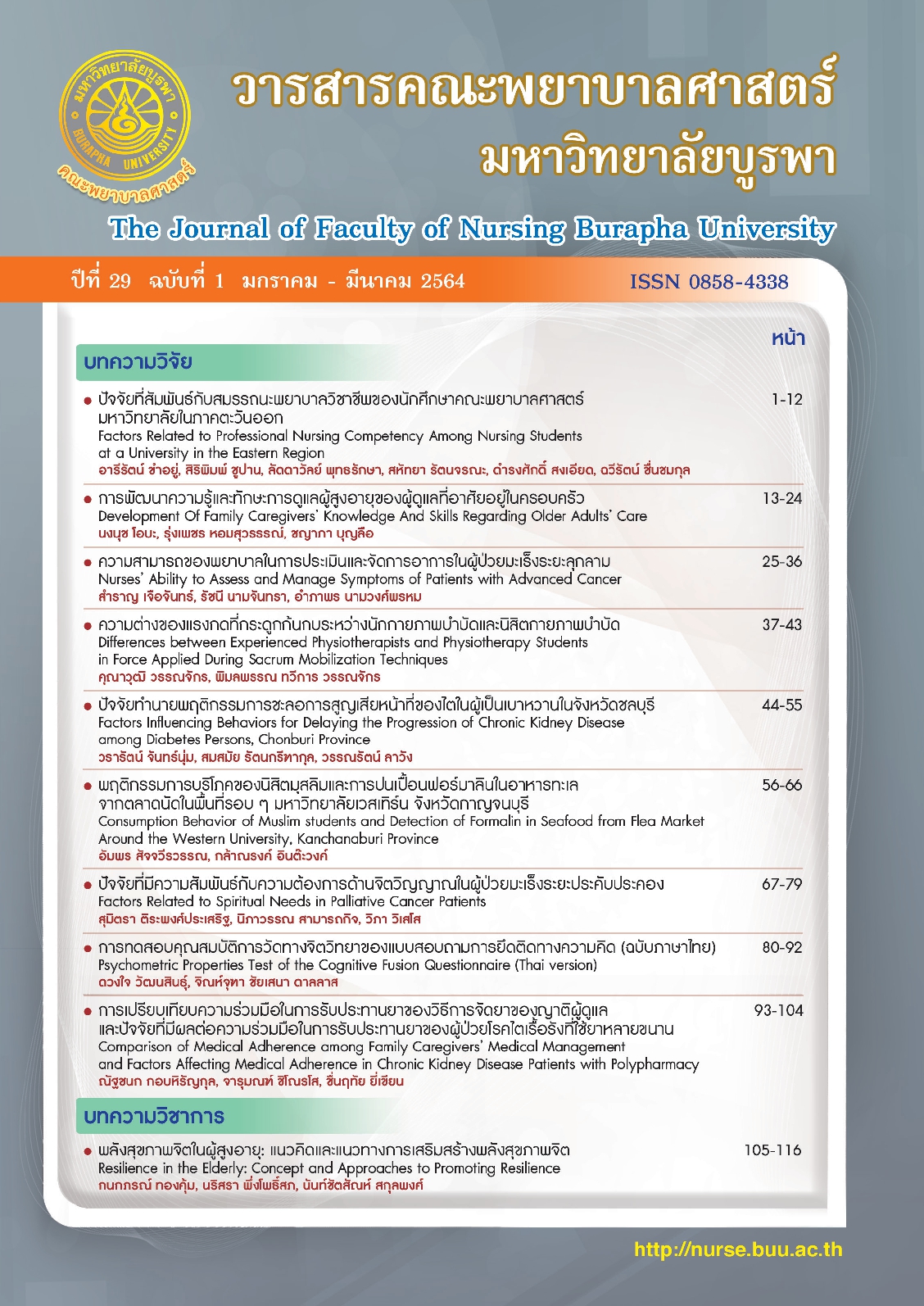การทดสอบคุณสมบัติการวัดทางจิตวิทยาของแบบสอบถามการยึดติด ทางความคิด (ฉบับภาษาไทย)
คำสำคัญ:
แบบสอบถามการยึดติดทางความคิด, เยาวชนผู้ใช้สารเสพติด, คุณสมบัติการวัดทางจิตวิทยาบทคัดย่อ
การวิจัยแบบภาคตัดขวางนี้มีวัตถุประสงค์เพื่อทดสอบคุณสมบัติการวัดทางจิตวิทยาของแบบสอบถามการยึดติดทางความคิด ฉบับภาษาไทย กลุ่มตัวอย่างเป็นเยาวชนที่กำลังเข้ารับการบำบัดสารเสพติดในโรงเรียนวิวัฒน์พลเมือง เขตพื้นที่ภาคตะวันออก จำนวน 350 คนที่ได้รับการสุ่มด้วยวิธีการสุ่มอย่างง่าย เครื่องมือวิจัยประกอบด้วย แบบสอบถามข้อมูลส่วนบุคคล และแบบสอบถามการยึดติดทางความคิดฉบับแปลเป็นภาษาไทยด้วยเทคนิคการแปลย้อนกลับ วิเคราะห์ข้อมูลด้วยสถิติพรรณนา ค่าสัมประสิทธิ์แอลฟาของครอนบาค การวิเคราะห์องค์ประกอบเชิงสำรวจ และการวิเคราะห์องค์ประกอบเชิงยืนยัน
ผลการวิจัยพบว่า แบบสอบถามการยึดติดทางความคิดฉบับภาษาไทยมีความเที่ยงและความตรงเชิงโครงสร้างอยู่ในเกณฑ์ดี โดยมีค่าสัมประสิทธิ์แอลฟาของครอนบาคเท่ากับ .84 ผลการวิเคราะห์องค์ประกอบเชิงสำรวจพบว่า แบบสอบถามมีเพียงองค์ประกอบเดียว ส่วนการวิเคราะห์องค์ประกอบเชิงยืนยันพบว่า โมเดลปรับปรุงมีความสอดคล้องกับข้อมูลเชิงประจักษ์ (χ2=11.66, p=.308, df=10, χ2/df = 1.16, GFI=.99, AGFI=.97, CFI=1.00, SRMR=.019 และ RMSEA =.022) โดยมีค่าน้ำหนักของข้อคำถามรายข้อระหว่าง .38-.78
ผลการศึกษามีข้อเสนอแนะว่า บุคลากรทางด้านสาธารณสุขสามารถนำแบบสอบถามฉบับนี้ไปใช้ในการประเมินการยึดติดทางความคิดของเยาวชนที่ใช้สารเสพติดเพื่อวางแผนการบำบัดหรือปรับเปลี่ยนพฤติกรรมได้อย่างเหมาะสม นอกจากนี้ควรมีการศึกษาเพิ่มเติมเพื่อพัฒนาปรับปรุงข้อคำถามของแบบสอบถามให้มีความสอดคล้องกับบริบทของสังคมไทยมากขึ้น
เอกสารอ้างอิง
Bai, Z., Luo, S., Zhang, L., Wu, S., & Chi, I. (2020). Acceptance and commitment therapy (ACT) to reduce depression: A systematic review and meta-analysis. Journal of Affective Disorders, 260, 728-737.
Bunyathikan, T., Soonthornchaiya, R., & Charernboon, T. (2020). The effects of acceptance and commitment therapy program on the depressive symptoms of elderly patients with major depressive disorder. The Journal of Psychiatric Nursing and Mental Health, 34(2), 118-131.
[In Thai]
Dallas, J. C., Vatanasin, D. Moungkum, S., Jullamate, P. Detchaiyot, P., Puapan, S., Pratumsri, W., Khuniontrtong, M., & Bunprachum, S. (2021). Research synthesis on the developmental guideline for resilience in youths with substance abuse based on acceptance commitment therapy in Thai society context. Journal of the NACC Office, 36(3), 57-69. [In Thai]
DeVellis, R. F. (2016). Scale development: Theory and applications (4th ed.). Los Angeles: Sage Publications.
Donati, M. A., Berrocal, C., Bernini, O., Gori, C., & Primi, C. (2021) Measuring cognitive fusion through the cognitive fusion questionnaire-7: Measurement invariance across non-clinical and clinical psychological samples. PLoS ONE, 16(2), 1-15.
Gillandersa, D. T., Bolderstonb, H., Bondc, F. W., Dempsterd, M. Flaxmane, P. E., Campbelld, L., Kerrd, S., Tanseyf, L., Noelg, P. Ferenbachh, C., Masleyd, S., Roacha, L., Lloydc, J., Mayc, L., Clarkei, S., & Remington, B. (2014). The development and initial validation of the cognitive fusion questionnaire. Behavior Therapy, 45(1), 83–101.
Hair, J. F., Black, W. C., Babin, B. J., & Anderson, R. E. (2019). Multivariate data analysis (8th ed.). Hampshire: Cengage Learning.
Halliburton, A. E. & Cooper, L. D. (2015). Applications and adaptations of acceptance and commitment therapy (ACT) for adolescents. Journal of Contextual Behavioral Science, 4(1), 1-11.
Harris, E. & Samuel, V. (2020). Acceptance and commitment therapy: A systematic literature review of prevention and intervention programs for mental health difficulties in children and young people. Journal of Cognitive Psychotherapy: An International Quarterly, 32(4), 280-303.
Hayes, L., Boyd, C. P., & Sewell, J. (2011). ACT for the treatment of adolescent depression: A pilot study in a psychiatric outpatient setting. Mindfulness, 2(2), 86-94.
Hayes, S. C., Luoma, J. B., Bond, F. W., Masuda, A., & Lillis, J. (2006). ACT: Model, processes and outcomes. Behaviour Research and Therapy, 44(1), 1-25.
Hoseini, S. M., Rezaei, A. M., & Azadi, M. M. (2014). Effectiveness of acceptance and commitment group therapy on the self-management of type 2 diabetes patients. Journal of Clinical Psychology, 5(4), 55-64.
Kim, B.-O., & Cho, S. (2015). Psychometric properties of a Korean version of the cognitive fusion questionnaire. Social Behavior and Personality: An International Journal, 43(10), 1715–1723.
Kongprapun, N., Hanjone, J., & Supwirapakorn, W. (2019). A development of quality of life of male to female transgender by acceptance and commitment group therapy. Journal of Police Nurse, 11(1), 216-227. [In Thai]
Kumlerd, S., Haenjohn, J., & Supwirapakorn, W. (2019). Development of problem-solving training program based on acceptance and commitment therapy in adolescents and young adults with amphetamine addiction. Journal of The Royal Thai Army Nurses, 20(1), 181-187. [In Thai]
Lee, E. B., An, W., Levin, M. E., & Twohig, M. P. (2015). An initial meta-analysis of Acceptance and Commitment Therapy for treating substance use disorders. Drug and alcohol dependence, 155, 1-7.
Livheim, F., Hayes, L., Ghaderi, A., Magnusdottir, T., Hogfeldt, A., Rowse, A, Turner, S. Hays, S. C., & Tengstrom. (2014). The effectiveness of acceptance and commitment therapy for adolescent mental health: Swedish and Australian pilot outcomes. Journal of Child and Family Studies, 24(4), 1016-30.
Nitayawan, S., Rungsiwaroj, N. & Phajuy, A. (2018). The process of treatment among drug dependent patient. Journal of Nurses Association of Thailand Northern Office, 24(1), 15-27. [In Thai]
Pett, R. A. Duenas, J. A., & Gaynor, S. T. (2017). Acceptance and commitment therapy for adolescent depression: Application with a diverse and predominantly socioeconomically disadvantaged sample. Journal of Contextual Behavioral Science, 6(2), 134-144.
Ruiz, F. J., Suárez-Falcón, J. C., no-Hernández, D. R., Gillanders, D. (2017). Psychometric properties of the cognitive fusion questionnaire in Colombia. Revista Latinoamericana de Psicología, 49(1), 80-87.
Roberts, S. L., & Sedley, B. (2016). ACT with older adults: Rationale and case study of an 89-year-old with depression and generalized anxiety disorder. Clinical Case Studies, 15(1), 53-67.





